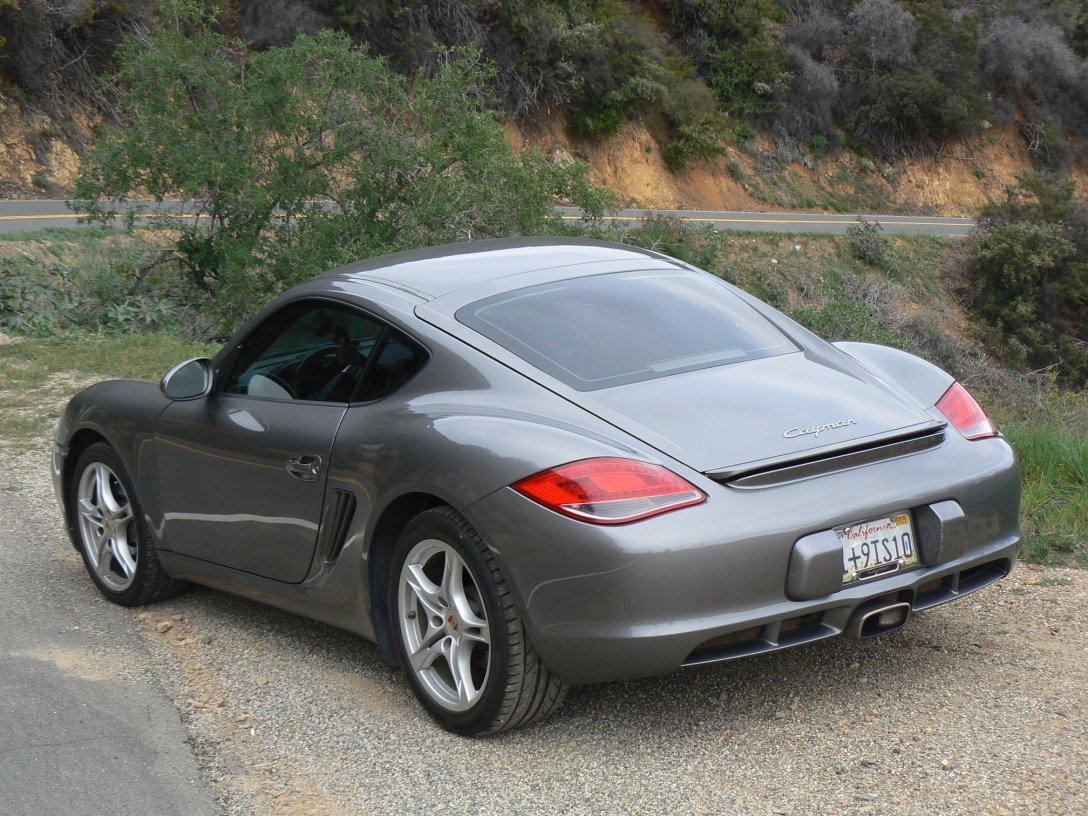My BCFF (Best Car Friend Forever) and I have been discussing the 2009 Porsche Cayman (987.2) at length because it is said to have the most reliable and robust engine of any first generation (987) Cayman. 2009 was a mid-run refresh for the Cayman. While the Cayman S moved up to a new direct-injection engine (with its own unique set of problems), the base engine stayed with a tried-and-true port-injected design and fixed the IMS bearing problem which plagued (and devalued) prior Caymans. With 987.2 Cayman prices falling to everyman levels, we felt the need to get some time behind the wheel and see if this midengined sports car deserves a place in our garage.
The Cayman I’ve rented has nearly 70,000 miles on its 2.9L flat-six engine and is shifted by a 6-speed manual transmission. Its interior is a little worn—the rubberized coatings on the plastics are peeling away—and the metallic gray exterior has a few minor dings and scratches. But never mind all that, this is a bona fide Porsche!
It’s early morning when the car is dropped off at my house, and my wife and I immediately take it on a drive down to Sunset Blvd. The initial impressions are good; the Cayman has that signature Porsche flat-six engine note, wonderful sports seats that sit you low-low to the ground and comfortably cosset you tightly with deep hip and torso bolstering, an intimately-sized cabin, and steering through which the texture of the pavement can be discerned. That last point is most important to me, and I spend our first ten miles in the car driving over Bott’s Dots and other road imperfections just so that I can feel the steering twitch under my fingertips. I marvel at the engine and clutch sounds that are coming from behind my back. I’ve had two other mid-engine drives in my life (981 Boxster S, Ferrari 360), but those memories have faded with time. I am not sure if I am imagining it or truly feeling it, but the Cayman gives me a feeling of solidity and weight just behind my shoulders.
Turning a critical eye on this Cayman, I can see it hasn’t had the easiest five years of life. While the shifting action on the 6-speed manual is still accurate and positive, the shifter itself can be rattled back and forth a few millimeters within each gate. This wiggle feels sloppy and out of place in a car that is otherwise so solid. Similar evidence of wear is felt in the connections between the solid and untwisting chassis and wheels. There seems to be a little slop and inaccuracy in the bushings or suspension; the car’s initial turn-in and composure over bumps are not as on-point as I’d expect it to be.
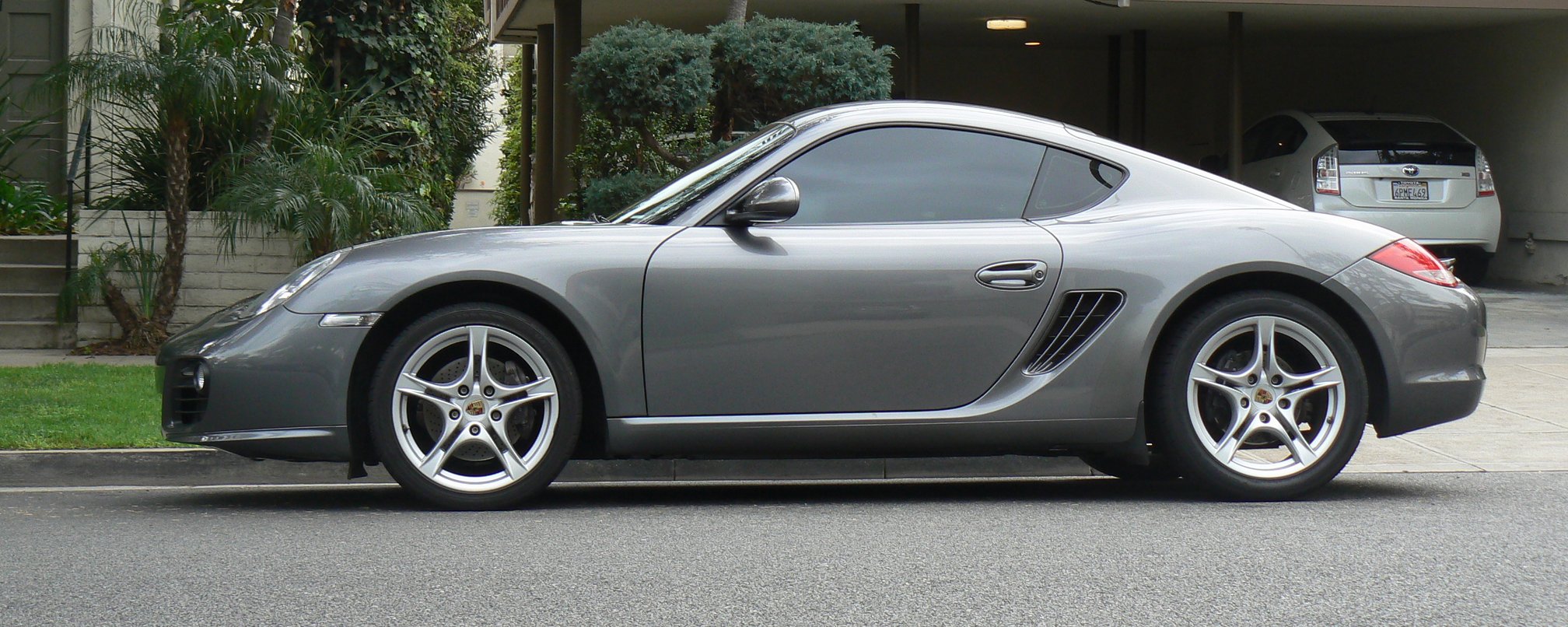
I try a few full power blasts and surprise my wife with the Cayman’s acceleration. To her, the Porsche feels faster than its speedometer indicates. But then she has the added benefit of being in the passenger seat, where every car feels 25% faster than it is. To me, as the driver, the torque from the engine seems just adequate for a sports car. The unit pulls linearly throughout the rev-range, with a short peak in torque around 5k rpm (which resides by 6k rpm), and the taper at the top does not entice me to redline. (Also, I know the rental company will be looking for over-revs.) I am finding, though, that there is no shortage of opportunities to wood the throttle.
We end our short jaunt, and I am hopeful for what tomorrow will bring with the Cayman. This platform has clear goodness to it, but it has not yet stolen my heart. In the canyons, it might shine very bright!
The Porsche is parked for a few hours while I slog down and back to Orange County in my 2011 BMW M3. The biggest contrast in getting back into my personal car is the feel of the seats—does the M3 not love me so? The BMW is not holding me with the tight affection I received from the Cayman. Also, I feel like I am sitting up so high in the M3! My car’s engine certainly has the advantage with its sweet note and pull.
Sage is already waiting in my driveway in his 1999 Porsche Boxster when I return home. He, too, is excited to try out the Cayman, and I thought comparing it to a similar Porsche could be interesting. Sage’s car is largely stock; its primary upgrade is a set of track-ready Hankook RS-3 tires.
Start we always do, heading west along the PCH towards Malibu. Sage and I take turns chasing each other away from stoplights; there does not seem to be much difference in the acceleration between the two cars. In the Cayman, good brisk acceleration is accompanied by that classic Porsche melody, but nothing is shocking, awesome or spine-tingling about a run from 0-to-60 mph. My E90 M3 wows with top-end power and a thrilling induction note. The Mustang GT—a recent rental—delivers guttural tire-scrabbling twist. The Cayman can hardly chirp its tires.
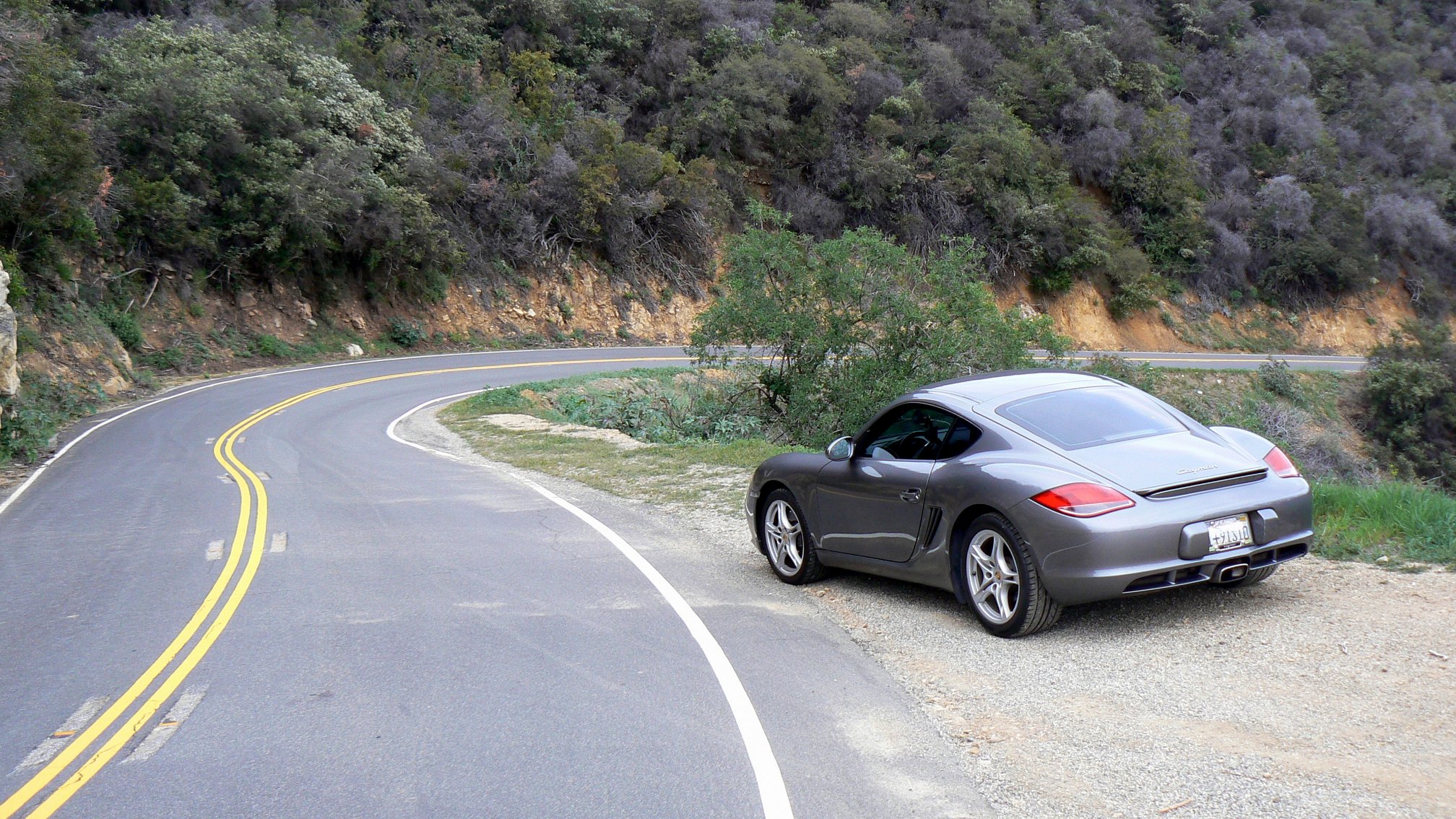
Otherwise, the Cayman is proving its merits while cruising. The ergonomics of the cockpit are excellent. The positioning of the shifter in my right-hand is perfect and aligns my forearm parallel to the ground. I feel like I am positioned to use all of my arm strength in each shift, not that brute-force is necessary as the shift action is easy if a little notchy. The steering has an adjustable tilt, and I’ve found a comfortable setting. There appears to be plenty of headroom for a helmet. My main complaint about the cabin is that it feels—but not sounds—boomy. In my ears, I can feel the cabin pressure jittering as I traverse bumps, and the sensation is slightly displeasing.
Latigo Canyon is Malibu’s double black diamond run of a road, and I cannot think of a better place to try out a car so willing to turn. I turn onto Latigo ahead of Sage and quickly turn up the wick to an eight-tenths pace. At its base, Latigo is more flowing than twisting, and second gear is a little too short, and the third gear is a little too long for this stretch. Forced to choose, I stick to second because the power is so much better there.
Flying into the first few tight corners, the Cayman reveals its weaknesses to me. The brakes are a bit dull and don’t wrench the car down with the immediacy I expect from a Porsche. Worse still are the mismatched tires (Hankook V4 ES front and V12 Ventus Evo 2 rear), which have only slightly sporty intentions and lack the grip to deliver the braking and turning performance the car deserves. They also are quick to complain, and I have them howling through more than a few corners. But brake pads and tires are easily upgraded components, and I am willing to chalk up these deficiencies to the cheapness of the rental company. After all, they are renting out the Cayman for profit, and I understand why they have not fitted the best consumables on the market to this car.
Latigo tightens into back-to-back twists as we climb, allowing the Cayman to show its greatest strength. Centering the engine so low between the four wheels results in a willingness to turn unlike anything I have experience in a front-engined car. There is no sense of resistance from the nose and no need to pause and let settle the transferring weight of an engine over the front tires. Instead, quick left-right transitions in the Cayman are seamless, effortless. I can flick from side to side as quickly as I want, and I never need to wait and let the car catch up with my inputs. In other cars, I have to measure my inputs to carefully shift and place weight; the Cayman keeps up with me regardless of the rapidity of my inputs.
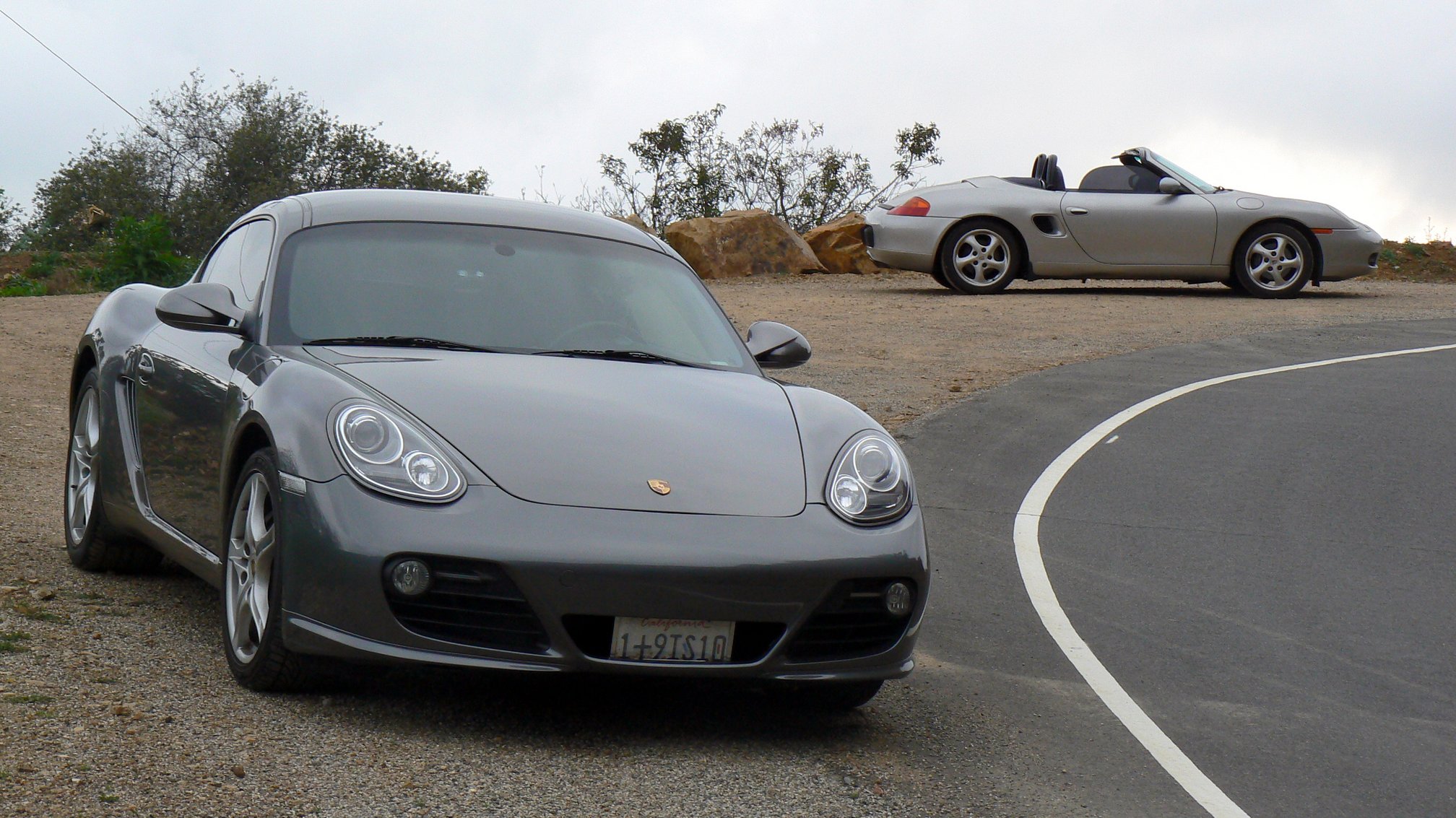
I don’t want to confuse this willingness to turn with eagerness to turn. The Evo IX and Focus ST are cars that I would say are eager to turn; they have very quick steering ratios and immediate off-center steering response. I cannot help but be psychologically affected when behind the wheel of those machines, as they amplify my hand movements seemingly encourage me to attack each corner. This Cayman, however, is actually a little slow and a little inconsistent in its response to initial steering inputs. I blame the inconsistency on poor tires and slightly tired suspension; the lack of eagerness I attribute to the more moderate steering ratio and, again, the poor tires.
Half-way up Latigo, the road narrows and tightens, and I start to draw from those last tenths of the Cayman’s performance. The confidence I get from the chassis overcomes the deficiencies of the brakes and tires. My bravado is not enough to shake the Boxster; Sage is still large in my mirrors. I edge away from him slightly on the straightaways, but he is glued to me in the corners.
The Cayman howls and ultimately understeers in the tightest turns, but I have the utmost confidence in making each corner. This is not a flailing, out-of-control car, but rather one which is hunkered down and precise. Bumps and off-camber turns do not fluster the chassis. There is somebody roll—Porsche has paired a softer, long-travel suspension to the Cayman’s stiff body—but it is just more informative than alarming. The steering lightens slightly with acceleration and becomes heavier under cornering and braking. (I don’t remember ever feeling any chatter of understeer through the rim.) I know what is happening at all four wheels of the car, and I can pick out which wheels are being individually braked by the ABS.
I pull over at Latigo’s summit, turn off the engine and climb out of the car, grinning broadly. The brakes are stinking! Sage says he had smelled them all the way up the canyon. The joys of open-top motoring! Sage says the Cayman was getting away from him on the straights and blames the Boxster’s long gearing and power deficiency. The gearing in the Cayman is not too short either.
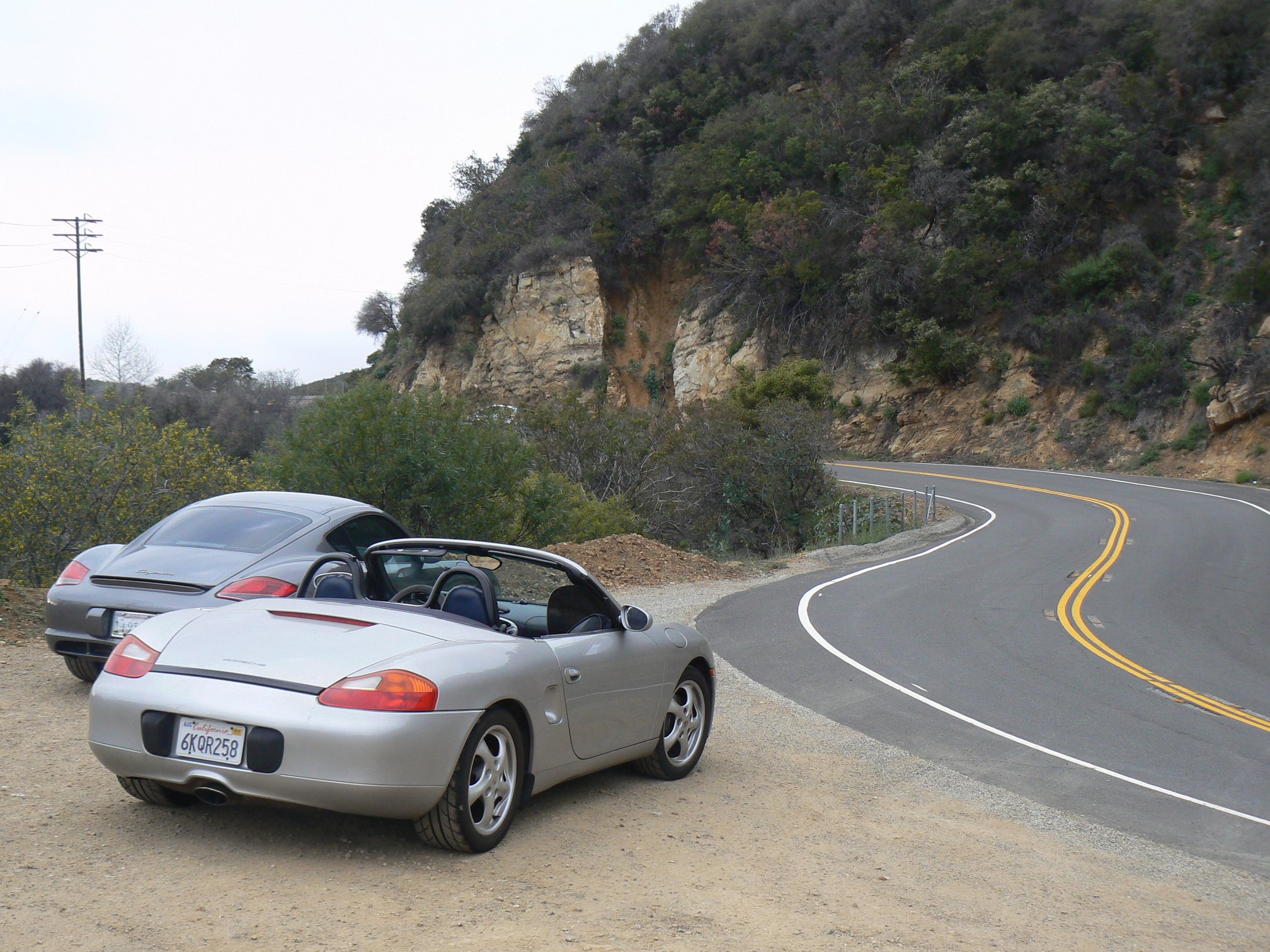
I take some photos, then we switch cars and head back down the canyon. Surprisingly, the steering in the Boxster is much, much heavier than that in the Cayman! Further blunting my enjoyment is the thick aftermarket-padding wrapping the Boxster’s wheel and absorbing some road feel. The Cayman’s wheel was thin, hard and nicely weighted, falling between the heavy steering of the M3 and the light and quick steering of the Evo IX. The Cayman gave me the sense that the steering is only lightly assisted, but the wheel is still easy to turn since the car’s nose is so light. In the Boxster, I am quickly finding that the primary information communicated through the wheel is scuttle-shake. The old convertible is not structurally solid, and there is flex between the front and rear of the car. The Boxster’s positives are its firm brake pedal and strong retardation, plus its sticky tires. How nice would it be to transfer both of these components to the Cayman!
The ride down the hill is hilarious, mainly because Sage is so much faster than am I! Sage slows down sporadically to let me catch up, and then we both get on the gas and attack again. In two corners, he is completely gone from view. All the confidence I had in the Cayman is gone in the Boxster; my seating position is too close to the wheel, my knees bump the rim, the steering is heavy and slow, and the car wobbles and shutters over bumps. Oh well, at least the engine note is good, and the Cayman is too far ahead for me to smell its overworked brakes!
At the bottom of Latigo, I jump in the Cayman as Sage’s passenger. Sage whips it back up the mountain, tires squealing through the corners. Sage is much better at extracting performance from an unfamiliar car, and he demonstrates how he can provoke throttle-on rotation at the exit of corners…something I had not been cornering hard enough to manage. The traction control system is on, so there are no sideways antics, but he proves that the Cayman could get sideways with sufficient commitment. Sage gripes about the brakes and tires too and agrees that third gear is too long for this road. We both marvel at the comfort and support from the sports seats.
The sun is starting to set, and I suggest we try the nearby Corral Canyon Rd before the light is gone. I explored this road two weekends ago in my M3 and found it quite a twisty treat. The meadows are filled with green grasses and spring flowers as we climb away from the coast, and I am sure that Sage in the Boxster is enjoying the lovely coastal scents. In the Cayman, I have the windows down, and I am indulging my nostrils too. Malibu is a glorious playground for car enthusiasts!
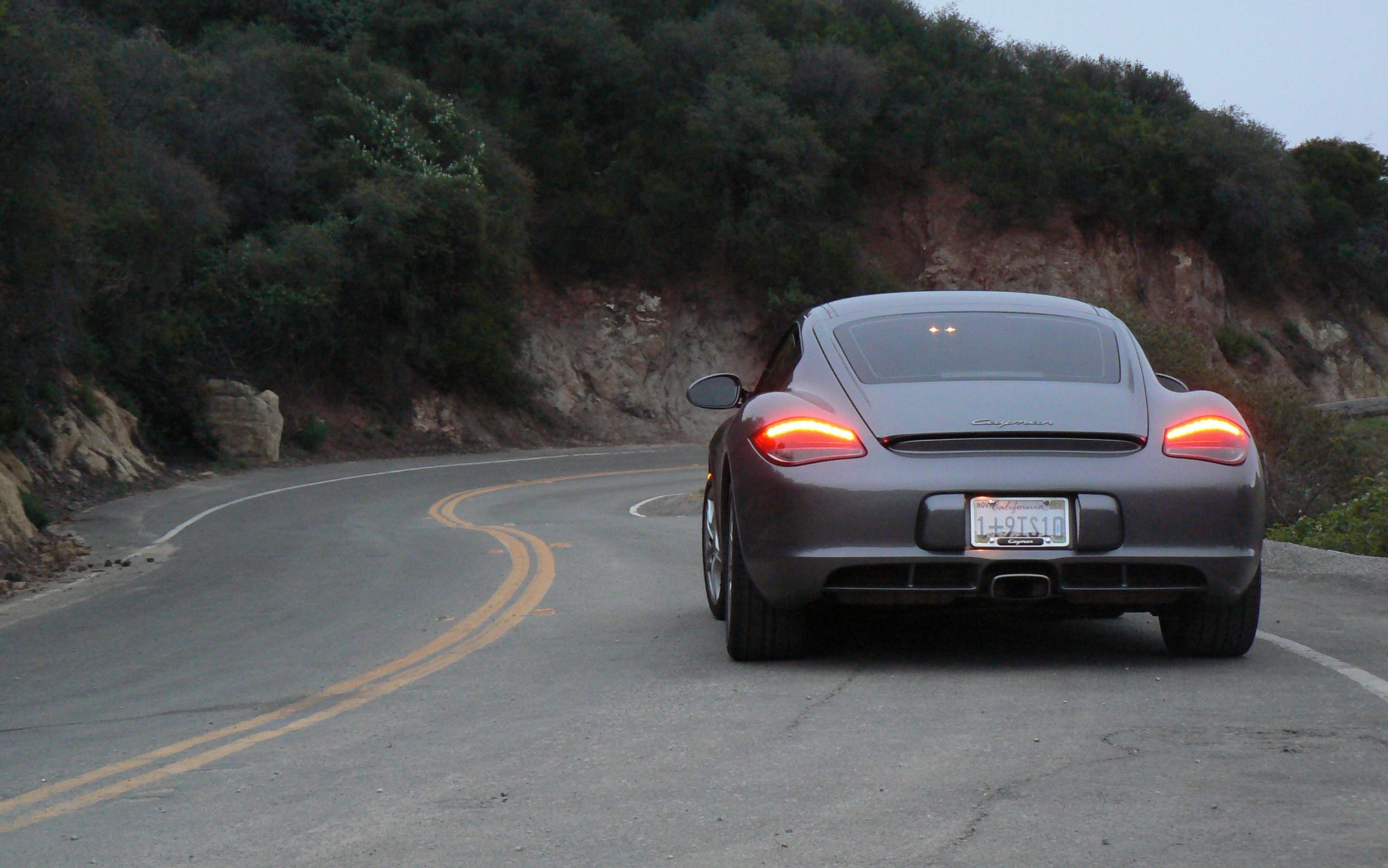
We take turns ripping up and down the final miles of Corral Canyon in the Cayman. The tight hairpins are particularly sweet as the Cayman takes them so well. The sun fades below the horizon, so we return to the Boxster and head back down towards the PCH. Not wanting this perfect motoring evening to end, I pull a U-turn within sight of the highway and blast back up Corral Canyon for one more run.
The cars that have really excited me of late have had some magical x-factor that brought them to a level beyond the competition. The E90 M3 is spine-tinglingly alive when dancing sideways through an autocross course. The Mustang GT excites with a ruckus soundtrack, pulse-quickening acceleration and deliciously mechanical shifts. The Evo IX becomes the best car in the world when you link a drift through multiple rows of a snow-covered parking lot and celebrate with AWD donuts. Where is the Cayman’s magic place? I had expected it to be Latigo Canyon—the most technical road in the Santa Monica Mountains—but there I found only excellence, not magic. I can see now why the automotive press has been clamoring for more power for the Cayman; if the upcoming GT4 marries this chassis to a GT worthy engine, then I believe the Cayman will reach another level altogether.
